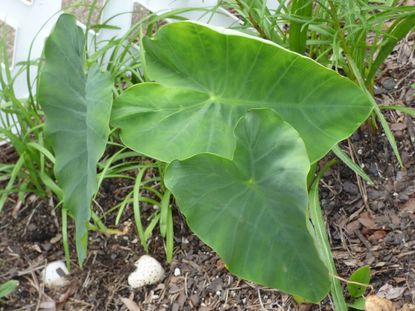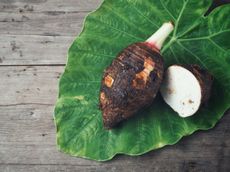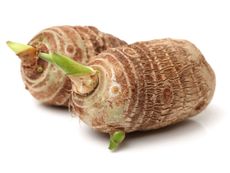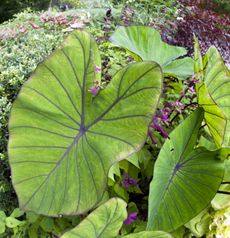Elephant Ear Problems: What To Do With Elephant Ears Taking Over Garden


The tropical elephant ear plant is a sight to behold and not one many will forget. The massive leaves and speedy elephant ear growth rate make this a plant that is perfect for maximum impact in the garden. Do elephant ears affect nearby plants? There are no allelopathic properties in the corms, but this can be an invasive plant and the excessive size may pose problems for species that live under the giant foliage. Choosing the right location for the plant and cleaning up after it drops its humongous leave should minimize any issues in the garden and keep your elephant ear garden friendly to all the other denizens of the landscape.
My Elephant Ears are Taking Over!
Fans of foliage plants should be well aware of the elephant ear’s charms. This tropical Arum is an excellent choice for pond edges, lightly shaded areas, and as screens for hiding unsightly items. These massive plants may grow up to 6 feet (2 m.) tall with leaves that span 2 feet (61 cm.) in diameter. In some areas, elephant ears are considered invasive, and some cautions should be taken to keep plants beneath free of debris. Otherwise, problems with elephant ear plants are rare and the statement making leaves are attractive foils for many other foliage and flowering specimens. For northern gardeners, the question, "Do elephant ears affect nearby plants?" is not even asked. That is because we are struggling to keep the plants alive over the winter. Most Colocasia are hardy to zone 9 or 8 with some mulching protection. In zones 7 and below, the corms must be dug up and overwintered indoors. Southern gardeners, on the other hand, will be well aware of elephant ear problems and may even vilify the plant in some instances. As a tropical species, Colocasia will have a rapid growth rate in warm conditions if given adequate water. This means you may have a monster of a plant in warm regions, and it is possible the giant specimen can escape cultivation. Even small fragments of the corms can reestablish and colonize natural areas. The massive plants then may crown out native species, making them an invasive flora.
Other Problems with Elephant Ear Plants
The most important criterion for growing Colocasia is well-drained, nutrient-rich soil. They can tolerate any lighting situation but prefer dappled or partially sunny sites. The huge 4 foot (1 m.) tall, thick petioles have quite a job sustaining the large leaves, so some staking may be required. Without support, the broad leaves have a tendency to droop and cover lower growing plants. They also replace the old leaves as the plant matures. This results in huge, dropped foliage, which can be a problem for any understory plants if left to rot on top of them. Simply cleaning up occasionally and tying up the leaves can remove these potential elephant ear problems. Fungal diseases as well as slugs and snails pose the biggest cultivation issues, but watering the root zone and setting bait can reduce much of the damage.
Running and Clumping Colocasia
Colocasia plant growth forms are something to watch for when purchasing corms. There are both running and clumping forms of elephant ear. The classic Colcasia esculenta, or Taro plant, is a good example of a running form. These plants produce underground stolons, which create new colonies of plants as they root. Disturbed stolons will also send up new shoots. These form dense colonies of plants quickly, an excellent trait in cropping situations but not so wonderful in the landscaped garden. Running varieties can make it feel as if elephant ears are taking over the garden beds. The issues with elephant ears are few and relatively easy to deal with as long as the plant doesn't escape cultivation or take over the garden. The rapid and impressive elephant ear growth rate is easy to control if you pot up the corms. In northern gardens, this also makes it easy to bring the plant indoors for overwintering.
Gardening tips, videos, info and more delivered right to your inbox!
Sign up for the Gardening Know How newsletter today and receive a free download of our most popular eBook "How to Grow Delicious Tomatoes."

Bonnie Grant is a professional landscaper with a Certification in Urban Gardening. She has been gardening and writing for 15 years. A former professional chef, she has a passion for edible landscaping.
-
 How To Get Rid Of Mosquitoes In The Garden: 9 Natural Ways To Make Them Buzz Off!
How To Get Rid Of Mosquitoes In The Garden: 9 Natural Ways To Make Them Buzz Off!How to get rid of mosquitoes is on the minds of people in the summer in almost every region of the world. Learn how to repel the pests without toxic chemicals.
By Mary Ellen Ellis
-
 Monkey Orchid Care: How To Grow This Fascinating Species
Monkey Orchid Care: How To Grow This Fascinating SpeciesThe monkey orchid (Dracula simia) bears a remarkable resemblance to its namesake and, with a little know-how, can be successfully grown as a houseplant.
By Bonnie L. Grant
-
 Can You Grow Taro In A Pot – Container Grown Taro Care Guide
Can You Grow Taro In A Pot – Container Grown Taro Care GuideTaro is a water plant, but you don’t need a pond or wetlands in your backyard to grow it. You can successfully grow taro in containers if you do it right. Click here and learn how to grow this plant in containers so you can enjoy the pretty tropical wherever you are.
By Mary Ellen Ellis
-
 Elephant Ear Plant Disease In Gardens: How To Treat Sick Elephant Ears
Elephant Ear Plant Disease In Gardens: How To Treat Sick Elephant EarsElephant ears are often grown for their huge, robust foliage. The leaves are prone to several diseases which mar this ornamental appeal. There are also diseases that can cause crown and root rot. If your plant has disease symptoms, this article can help.
By Bonnie L. Grant
-
 Elephant Ear Control – Ridding The Garden Of Unwanted Elephant Ear Plants
Elephant Ear Control – Ridding The Garden Of Unwanted Elephant Ear PlantsElephant ear plants are most often grown in cooler climates as an annual where they do not become a problem. However, in hot, humid, tropical locations, one little elephant ear plant can all too quickly become a mass of them. How do you get rid of elephant ears? Find out here.
By Darcy Larum
-
 Dividing Elephant Ears: How And When To Divide Elephant Ears
Dividing Elephant Ears: How And When To Divide Elephant EarsElephant ear division is useful to prevent overcrowding, produce more plants in a different location, and enhance plant health. It is important to know when to divide elephant ears to avoid plant injury or poor performance. This article will help.
By Bonnie L. Grant
-
 Growing Taro For Food: How To Grow And Harvest Taro Root
Growing Taro For Food: How To Grow And Harvest Taro RootAnother healthier option to the standard potato chip would be growing and harvesting your own taro roots and then turning them into chips. Want to find out how to grow and harvest taro in your own garden? This article will help get you started.
By Amy Grant
-
 Elephant Ear Plant Types: Learn About Common Elephant Ear Plants
Elephant Ear Plant Types: Learn About Common Elephant Ear PlantsElephant ears are one of those plants whose foliage receives double takes and oohs and aahs. There are different elephant ear plants in four genera available for growing in your landscape. Learn more about them in this article.
By Bonnie L. Grant
-
 Uses Of Dasheen Plants: Learn About Growing Dasheen Taro Plants
Uses Of Dasheen Plants: Learn About Growing Dasheen Taro PlantsYou probably have already heard of dasheen, just with a different name: taro. Check out this article for interesting dasheen plant info including what is dasheen good for and how to grow dasheen. Click here for more.
By Amy Grant
-
 Elephant Ear With Brown Edges: Why Do Elephant Ear Plants Get Brown On Edge
Elephant Ear With Brown Edges: Why Do Elephant Ear Plants Get Brown On EdgeYou can't ask for more visual impact than the large leaved Colocasia, or elephant ear plant. That said, leaf browning on elephant ears is a common complaint. Why do elephant ear plants get brown on edge? Find out in this article.
By Bonnie L. Grant